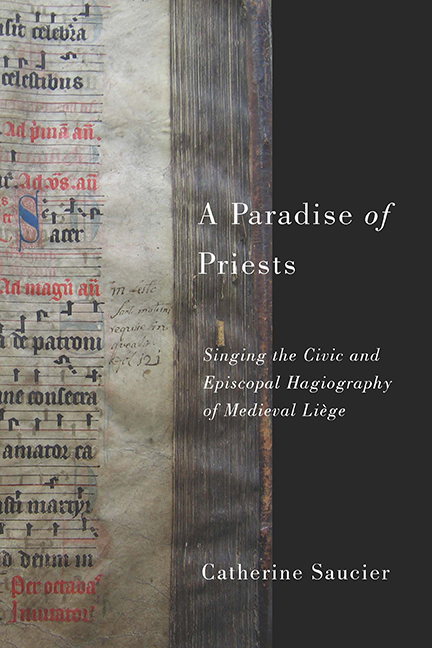Book contents
- Frontmatter
- Dedication
- Contents
- List of Illustrations
- Acknowledgments
- Abbreviations
- Note on Editorial Conventions
- Introduction: The Sound of Civic Sanctity in the Priestly Paradise of Liège
- 1 Martyred Bishops and Civic Origins: Promoting the Clerical City
- 2 The Intersecting Cults of Saints Theodard and Lambert: Validating Bishops as Martyrs
- 3 The Civic Cult of Saint Hubert: Venerating Bishops as Founders
- 4 Clerical Concord, Disharmony, and Polyphony: Commemorating Bishop Notger's City
- 5 Military Triumph, Civic Destruction, and the Changing Face of Saint Lambert's Relics: Invoking the Defensor Patriae
- Conclusion: Hearing Civic Sanctity
- Appendix: Service Books Preserving the Medieval Chant Repertory Sung in the City of Liège
- Notes
- Bibliography
- Index
2 - The Intersecting Cults of Saints Theodard and Lambert: Validating Bishops as Martyrs
Published online by Cambridge University Press: 15 March 2018
- Frontmatter
- Dedication
- Contents
- List of Illustrations
- Acknowledgments
- Abbreviations
- Note on Editorial Conventions
- Introduction: The Sound of Civic Sanctity in the Priestly Paradise of Liège
- 1 Martyred Bishops and Civic Origins: Promoting the Clerical City
- 2 The Intersecting Cults of Saints Theodard and Lambert: Validating Bishops as Martyrs
- 3 The Civic Cult of Saint Hubert: Venerating Bishops as Founders
- 4 Clerical Concord, Disharmony, and Polyphony: Commemorating Bishop Notger's City
- 5 Military Triumph, Civic Destruction, and the Changing Face of Saint Lambert's Relics: Invoking the Defensor Patriae
- Conclusion: Hearing Civic Sanctity
- Appendix: Service Books Preserving the Medieval Chant Repertory Sung in the City of Liège
- Notes
- Bibliography
- Index
Summary
Saints Theodard and Lambert shared a distinctive rank in the liégeois rite. Of the thirteen local bishops featured in the annual cycle of saints’ feasts, these two alone were classified as martyrs. Through their martyrial status, Theodard and Lambert thus outshone the most distinguished early bishops of the diocese—Maternus (the diocesan “founder” and first bishop of Tongeren) and Servatius (first bishop of Maastricht)—venerated as mere confessors. Hagiographers recognized this distinction, as we might recall from Sigebert of Gembloux's late eleventh-century Vita Theodardi:
God did not wish Theodard and Lambert to be far separated in burial. Foreseeing that they alone of all the bishops of Tongeren would be equal in the glory of martyrdom, he wished them also to be equal in the grace of merits. Theodard only preceded Lambert [in death] lest Lambert be the first martyr in this church; and Lambert preceded Theodard [in his burial] lest Theodard be the only martyr in this church.
[Noluit Deus longe a se disiungi tumulo quos solos e numero Tungrensium episcoporum sibi equales per martirii gloriam preuidebat equales fore etiam per meritorum gratiam. Preripuit tantummodo Theodardus Lamberto ne primus in hac ecclesia esset martyr, preripuit Lambertus Theodardo ne solus in hac ecclesia foret martyr.]
Sigebert's astute emphasis on the “equality” of the two episcopal martyrs concisely summarizes the multiple ways in which their cults would intersect. As we observed in chapter 1, Lambert figured prominently in Theodard's vita and liturgy as an active agent in the translation of Theodard's relics from the site of his martyrdom (near Speyer) to Liège—the very place soon to witness Lambert's own martyrdom. Similarly, we find a reciprocal association in the earliest extant hagiographic reference to Saint Theodard, which appears, significantly, in the Vita prima of Saint Lambert (written between 727 and 743). Both in life and especially in death, the two bishops shared an exceptional bond—as recognized explicitly in hagiographic literature and celebrated musically in the local liturgy.
Hagiographic and liturgical parallels between Saints Theodard and Lambert were especially tangible in the church housing their remains. While the cathedral marked the epicenter of Lambert's cult, built over the very soil sanctified by the titular patron's martyrial blood, this church also cultivated a special devotion to Theodard.
- Type
- Chapter
- Information
- A Paradise of PriestsSinging the Civic and Episcopal Hagiography of Medieval Liège, pp. 49 - 93Publisher: Boydell & BrewerPrint publication year: 2014

